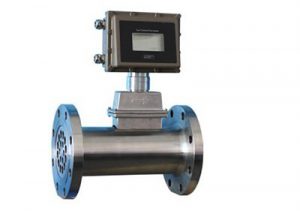Advantages
(1) High accuracy: gas turbine flowmeter, the full range is generally 1.0%~2.0%, and the high accuracy type is 0.5%~1.0%. Among all flow meters, it is one of high accuracy.
(2) Good repeatability, generally up to 0.05% ~ 0.2%. Because of its good repeatability, high accuracy can be achieved after frequent calibration or online calibration, so it is one of the preferred flow meters in trade settlement.
(3) The range is wide, the medium and large diameters are generally up to 20:1 or more, and the small diameters are 10:1, and the starting flow rate is also low.
(4) The pressure loss is small, generally (0.1~2.5)kPa under normal pressure.
(5) Compact structure, light volume, convenient installation, and use, and large-circulation capacity.
(6) Multiple display modes can be used. It can only be equipped with a mechanical counter or only an ordinary flow totalizer, or a temperature and pressure compensator can be added to the mechanical counter, or only with a temperature and pressure compensator, and it can be battery-powered for a long time (can run continuously for more than two years, there are The product is up to five years), easy to use.
(7) Since the pulse frequency signal output is generally adopted, it is suitable for cumulative flow measurement and connection with a computer, without zero drift, and strong anti-interference ability. At the same time, if the high-frequency signal output is adopted, a very high-frequency signal (3kHz ~ 4kHz) can be obtained, and the signal resolution is strong.
(8) For large-caliber measurement, it can be made into a plug-in type, with low-pressure loss, low price, continuous flow and removal, and easy installation and maintenance.

Disadvantages
(1) To maintain the calibration characteristics for a long time, regular calibration is required. Suspended substances or corrosive components contained in the medium will cause problems such as bearing wear and jamming, which will change its accuracy and limit its scope of application. Although the situation has improved after the use of wear-resistant hard alloy shafts and bearings, this problem still exists, so it must be calibrated regularly. For those with trade storage and high-accuracy measurement requirements, it is best to equip them with on-site calibration equipment.
(2) It is necessary to add oil regularly to ensure sufficient lubrication of the bearing to ensure the accuracy of measurement and prolong the service life.
(3) The physical properties of the medium (such as density, viscosity, etc.) have a greater impact on the characteristics of the turbine flowmeter. Gas flow meters are susceptible to density and are closely related to temperature and pressure, so temperature and pressure corrections are required.
(4) Turbine flowmeters are greatly affected by the distribution of the flow field. Therefore, for flowmeters without rectifiers at the inlet, straight pipe sections should be installed on the upstream and downstream sides of the sensor as required, and for flowmeters with rectifiers at the inlet should also be in accordance with the requirements of the instructions. Set a straight pipe section of a certain length.
(5) It is not suitable for use in occasions where there is a strongly pulsating flow, nor is it suitable for the measurement of mixed-phase flow.
(6) The cleanliness of the measured medium is relatively high, and the filter needs to be installed as required, but this also brings about an increase in pressure loss.
(7) The flow characteristics of small-diameter turbine flowmeters are seriously affected by physical properties, so it is difficult to improve the performance of small-diameter turbine flowmeters. For example, the smallest diameter is DN25, but its range is only 10:1, and the highest accuracy is only 1.0%.
